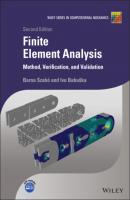Finite Element Analysis. Barna Szabó
Чтение книги онлайн.

Читать онлайн книгу Finite Element Analysis - Barna Szabó страница 47
Название: Finite Element Analysis
Автор: Barna Szabó
Издательство: John Wiley & Sons Limited
Жанр: Физика
isbn: 9781119426462
isbn:
The generalized form is obtained by multiplying eq. (1.133) by a test function
(1.134)
We now introduce
(1.135)
which can be written as
(1.136)
Since the functions on the left are independent of t, the function T depends only on t, both expressions must equal some positive constant denoted by
The function
(1.137)
the solution of which is
(1.138)
where ω is the angular velocity (rad/s). Alternatively ω is written as
To find ω and U we have to solve the problem
(1.139)
which will be abbreviated as
There are infinitely many solutions called eigenpairs
If the eigenvalues are distinct then the corresponding eigenfunctions are orthogonal: Let
Subtracting the second equation from the first we see that if
(1.141)